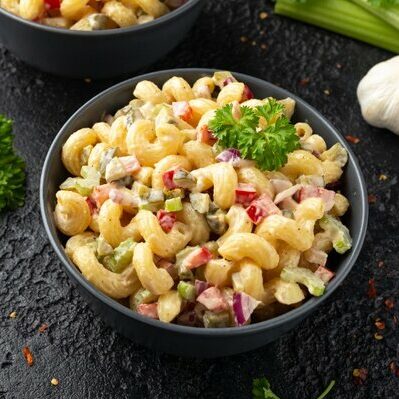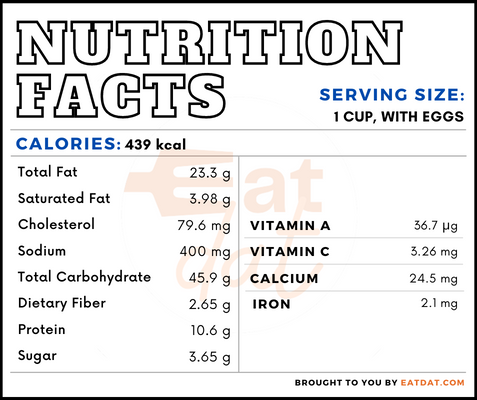
Macaroni Salad
What is Macaroni Salad?
Macaroni salad is a type of salad made with elbow macaroni pasta. In the Western world, it contains mayonnaise, red onions, boiled eggs, any type of hard cheese, red pepper, celery, and sweet pickles.
- In the Philippines, this type of salad is considered a dessert and contains cheese, jelly, and fruits.
- It is generally served chilled and is often included as a side dish at festivals and gatherings.
The top 10 most popular salads in the world include:
- Coleslaw
- Caesar Salad
- Greek Salad
- Caprese Salad
- Som Tam
- Macaroni Salad
- Olivier Salad
- Fattoush
- Chinese Chicken Salad
- Tabbouleh
Origin
Macaroni salad is of American origin. Though the basic ingredient (pasta) is Italian, Italian cuisine has no tradition of serving cold pasta with mayonnaise or vinegar. The first recorded recipe for such a meal is from the early 1900s in the United States. One theory claims that this dish is a mixture of the Italian pasta and the German potato salad. The dish was easy to prepare and cheap, which made it popular during the Depression years in the US.
Nutrition
Nutritional profile for macaroni salad (1 cup, with eggs):

Macaroni salad is rich in micronutrients such as calcium, magnesium, phosphorous, potassium, sodium, selenium, folate, folic acid, choline, vitamin A, retinol, carotene, cryptoxanthin, lutein + zeaxanthin, and vitamin K.
Pasta must be avoided by those with a gluten allergy. It is made from durum flour, which has a lower glycemic index than regular flour. Cold pasta is a good source of resistant starch. This makes macaroni salad a dish that can help control obesity, diabetes, and heart problems. Research shows that regular pasta eaters follow dietary patterns that give them higher amount of fiber and show an increased HEI (Healthy Eating Index).
However, mayonnaise is a high-fat food that can easily lead to diseases such as obesity and cardiovascular diseases, if consumed too much. However, in moderate quantities, it can be beneficial to health because it is rich in polysaturated fatty acids. Also, eggs are a nutrient dense food and contain several bioactive compounds.
Commercial production
Macaroni salad is a very popular salad in the United States and is found in most restaurants and fast food joints. Also, macaroni salad can be found in American-style restaurants in other countries.
To prepare a basic macaroni salad, the main ingredients required are any type of short pasta, red or green bell peppers, red onions, celery, hard boiled eggs (chopped), sweet pickles, and a mayonnaise-based dressing. First, the pasta is cooked in salted water, until it is al dente. Then, it is washed in cold water and drained. The remaining ingredients are added and mixed together until the pasta is well coated with the dressing. Finally, the dish is chilled for at least 2 hours before serving.
This salad can be stored in the refrigerator for up to 5 days. It must not be left out in room temperature for more than 2 hours.
Macaroni salad recipes
Macaroni salad can be prepared with different ingredients to fit a variety of tastes. Here are some recipes:
- Classic Macaroni Salad
- Amish Salad
- Hawaiian Mac Salad
- Cajun Pasta Salad
- Mexican Ham Salad
- Filipino Chicken Salad
- Filipino Sweet Salad
FDA regulations
The FDA classifies pasta under macaroni products, which is defined as food prepared by drying units of dough made from semolina, durum flour, farina, flour, or a combination of these with water and other optional ingredients.
Mayonnaise is classified as a food dressing by the FDA. It is defined as the emulsified semisolid food prepared from vegetable oils, acidifying ingredients, and egg yolk-containing ingredients. It must contain at least 65 percent of vegetable oil.
Cheddar cheese is defined as cheese prepared by adding hydrogen peroxide or catalase and lactic acid-producing bacterial culture to create a semisolid mass, in which the whey and curds are separated.
References
Fulgoni, Victor L 3rd, and Regan Bailey. “Association of Pasta Consumption with Diet Quality and Nutrients of Public Health Concern in Adults: National Health and Nutrition Examination Survey 2009-2012.” Current developments in nutrition vol. 1,10 e001271. 19 Sep. 2017, doi:10.3945/cdn.117.001271, https://www.ncbi.nlm.nih.gov/pmc/articles/PMC5998777/
Mirzanajafi-Zanjani, Mina et al. “Challenges and approaches for production of a healthy and functional mayonnaise sauce.” Food science & nutrition vol. 7,8 2471-2484. 18 Jul. 2019, doi:10.1002/fsn3.1132, https://www.ncbi.nlm.nih.gov/pmc/articles/PMC6694423/
Réhault-Godbert, Sophie et al. “The Golden Egg: Nutritional Value, Bioactivities, and Emerging Benefits for Human Health.” Nutrients vol. 11,3 684. 22 Mar. 2019, doi:10.3390/nu11030684, https://www.ncbi.nlm.nih.gov/pmc/articles/PMC6470839/#B26-nutrients-11-00684
